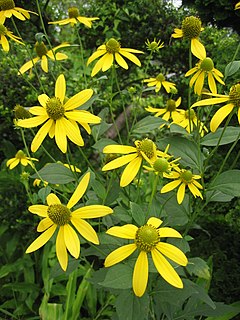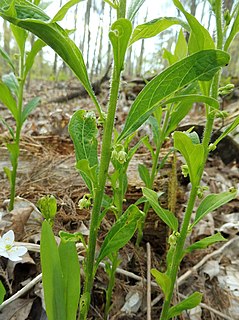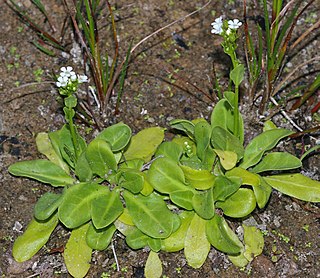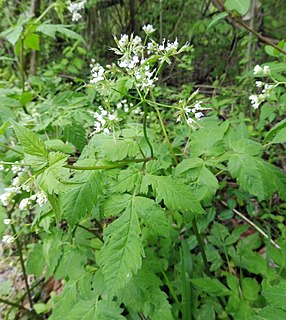
Araucaria heterophylla is a vascular plant in the ancient and now disjointly distributed conifer family Araucariaceae. As its vernacular name Norfolk Island pine implies, the tree is endemic to Norfolk Island, a small island in the Pacific Ocean between New Zealand and New Caledonia, about 1440 km east of Sydney, Australia. The genus Araucaria occurs across the South Pacific, especially concentrated in New Caledonia where 13 closely related and similar-appearing species are found. It is sometimes called a star pine, Polynesian pine, triangle tree or living Christmas tree, due to its symmetrical shape as a sapling, although it is not a true pine.

Rudbeckia laciniata, commonly called cutleaf coneflower, is a species of flowering plant in the aster family (Asteraceae). It is native to North America, where it is widespread in both Canada and the United States. Its natural habitat is wet sites in flood plains, along stream banks, and in moist forests.

Anemone caroliniana, the Carolina anemone, is a herbaceous plant species in the genus Anemone and family Ranunculaceae. Plants grow (7)10 to 40 cm tall, from short tuber-like rhizomes that are 10–30 mm long. Stem leaves without petioles. Plants flowering early to mid spring with the flowers composed of 10 to 20 sepals normally white or soft rose colored but also purple, one flower per stem, the sepals are 10 to 22 mm long and 2–5 mm wide. Fruits in heads ovoid to subcylindric in shape, 17–25 mm long.

Eurybia hemispherica, commonly known as the southern prairie aster, is an herbaceous plant in the composite family (Asteraceae). It is native to the south-central United States, primarily the lower Mississippi Valley and southeastern Great Plains, from Kansas south to Texas and east to Kentucky, Tennessee, and the Florida Panhandle. Its natural habitat is typically in upland prairies or dry savannas. It is less commonly found in open moist areas, in sandy-loamy soil.

Hybanthus concolor, commonly known as eastern green violet, is a flowering plant in the violet family (Violaceae). It is native to eastern North America, where it is found through much of the interior areas of the eastern United States and Ontario, Canada.

Samolus valerandi is a species of water pimpernel native to a very wide area across Europe, Africa, Asia, Australia, and the Americas. Common names include seaside brookweed, brookweed, thin-leaf brookweed, water cabbage, and water rose.

Erigeron annuus is a North American plant species in the daisy family.

Callitriche stagnalis is a perennial aquatic vascular plant species. Also known as pond water-starwort, C. stagnalis, may thrive in a variety of aquatic and subaquatic habitats, specially those exhibiting slowly moving to non-moving water. Although C. stagnalis does not pose a threat to humans, its reproductive rate may pose a threat to native vegetation. Resulting dense vegetative mats frequently out-compete species in native communities.

Callitriche marginata is a species of aquatic plant known by the common name winged water starwort.

Callitriche is a genus of largely aquatic plants known as water-starwort. Previously, it was the only genus in the family Callitrichaceae. However, according to the APG II system this family is now included in the Plantaginaceae. The family name Callitrichaceae retains its status as nomen conservandum.

Drosera heterophylla, the swamp rainbow, is an erect perennial tuberous species in the carnivorous plant genus Drosera that is endemic to Western Australia. It grows in shallow water swamps or wet clay flats near granite outcrops and occurs in the vicinity of Perth and to its north. D. heterophylla produces small leaves along an erect stem that can be 10–30 cm (4–12 in) tall. It is the only species in the genus that produces many-petaled flowers. These white flowers emerge from June to September.

Populus heterophylla, also known as downy poplar, swamp poplar and swamp cottonwood, is a large deciduous poplar belonging to Populus section Leucoides. It is found in wet bottomland forests, reaching a height of 100 feet (30 m) at full maturity and 50 feet (15 m) in 20 years. The swamp cottonwood is similar to the eastern cottonwood except the leaves are cordate (heart-shaped) instead of deltoid.

Osmorhiza longistylis, commonly called long-styled sweet-cicely or longstyle sweetroot, is an herbaceous plant in the carrot family (Apiaceae). It is native to North America, where it is found from the Rocky Mountains east to the Atlantic Coast, in Canada and the United States. Its natural habitat is in forests with fertile soil, often in areas of loam and dappled sunlight.. It can be found in areas of high or average quality natural communities, and does not tolerate intense disturbance.
Dodecatheon austrofrigidum is a species of flowering plant in the primrose family known by the common names frigid shooting star and tundra shooting star. It is native to Washington and Oregon in the United States, where it grows in the coastal mountain ranges, including those on the Olympic Peninsula.

Hypericum ascyron, the great St. Johnswort or giant St. John's wort is a wildflower in the genus Hypericum.

Symphyotrichum shortii, commonly called Short's aster, is a species of flowering plant in the aster family (Asteraceae). It is native to the United States, where it is primarily found in interior areas, east of the Mississippi River. Its natural habitat is in thin, rocky soils of woodlands and thickets, often around limestone bluffs. It is common throughout much of its range, although it is generally restricted to intact natural communities.

Hypericum tenuifolium, known as Atlantic St. John's-wort and sandhill St. John's-wort, is a species of flowering plant in the St. John's wort family, Hypericaceae. It is native to the Southeastern United States.

Hypericum frondosum, the cedarglade St. Johnswort or golden St. John's wort, is a species of flowering plant in the St. Johnswort family, Hypericaceae. It is native to the central and southeastern United States in dry, rocky habitats.

Hypericum fasciculatum, known as peelbark St. Johnswort or sandweed, is a species of flowering plant in the St. Johnswort family, Hypericaceae, native to the southeastern United States. It is found from eastern North Carolina, south to southern Florida, west to eastern Louisiana. Kew's Plants of the World Online database also notes that it occurs in Cuba, though Cuba is not listed in several other sources. It was first described in 1797 by Jean-Baptiste Lamarck.





















